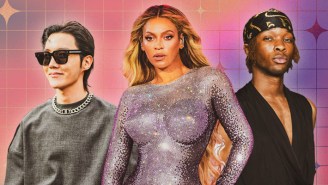This weekend, MTV confirmed that it is making an official pivot to its past: Total Request Live, the flailing network’s signature show back in the late ’90s and early ’00s, will return in October after a nine-year hiatus. MTV is investing in a massive new Times Square studio in the hopes of reviving a long-lost world in which social media doesn’t exist and Carson Daly is still in his twenties. “It’s the right route,” MTV president Chris McCarthy insisted in Sunday’s New York Times. “When you talk to artists and they say to you, unaware of what we’re doing, can you bring back TRL? We’d be crazy not to reinvent that.”
Except we all know this isn’t going to work, right?
Let’s be real — does anybody outside of MTV’s corporate office really believe that a music-video countdown show is the cure for what ails the beleaguered cornerstone of youth culture in the late 20th century? Isn’t the problem existential and irreparable, i.e. the fact that the late-20th century is now nearly two decades in the rearview?
The issues here are so obvious I feel a little silly enumerating them. I’ll just assume you know what I’m talking about. I won’t insult your intelligence by pointing out the myriad changes to media consumption habits since MTV’s prime. No doubt we’re all aware of Youtube and Spotify and Instagram and Facebook. I also don’t need to remind anyone that teenagers in the ’80s and ’90s tuned into MTV all day long because there was literally nothing else to do.
In spite of myself, I still care enough to have an opinion about MTV’s future. As someone who grew up watching music videos practically every day between the ages of 6 and 18, MTV is iconic to me, and I’ll always have positive feelings associated with the brand. But I’m also a 39-year-old man, hardly the desired demographic for a youth-oriented culture hub. For people who were born around the time that Daly left TRL in 2003, signaling the end of the program’s glory years, MTV’s brand value seems more dubious.
“MTV at its best — whether it’s news, whether it’s a show, whether it’s a docu-series — is about amplifying young people’s voices,” McCarthy told the Times. “We put young people on the screen, and we let the world hear their voices. We shouldn’t be writing 6,000-word articles on telling people how to feel.”
The indelicate shot at the recently reconfigured MTV News — whose staff McCarthy fired in June — aside, McCarthy’s sentiments here register as corporate PR at best and willful delusion at worst. McCarthy, a 42-year-old man who likely shares my fond if distant memories of MTV’s golden era, believes that kids who already have multiple avenues to amplify their own voices without MTV’s help will nonetheless turn to a monolithic relic of their parents’ youth in order to feel seen.
Classifying MTV as a dead brand might be a bridge too far — the Times reports a recent ratings surge among 18-to-34-year-olds in the past two months, the network’s first ratings increase over consecutive months in four years, thanks to a revived version of Fear Factor and an episode of Wild N’ Out starring Chance The Rapper that also scored MTV’s biggest audience among ages 12 to 17 for an unscripted show since 2015. But using TRL as a path forward seems like a road to yet another failure, which is clear if you know anything about the run of the original show.
Launched in 1998, Total Request Live was neither live nor a clearinghouse for “requests” — by this time, MTV was starting to phase out music videos as the core of its programming schedule, so viewers who honestly expected to see their favorite clips outside of Total Request Live were sorely mistaken. But the show didn’t achieve full-on TRL-ness until the following year, when a live audience was brought into the studio.
TRL‘s popularity peaked in 2000 and ’01, a time when radical changes to the business of buying and selling of music were already underway but hadn’t yet come into full effect. Online piracy swiftly became a phenomenon in dorm rooms across the country in 1999, but there were still millions of CD buyers willing to pay cash for Limp Bizkit’s Chocolate Starfish And The Hot Dog Flavored Water, an album that Fred Durst describes as a “gateway to our souls” in this vintage TRL interview from 2000. For a short time, TRL was so central to teen culture that it could actually generate news, like the time in 2001 when Mariah Carey stopped by unexpectedly and had an on-air meltdown involving a striptease and popsicles. But more than being a showcase for musicians, TRL was a chance for teenagers to watch other teenagers on television, just as American Bandstand was for an older generation.
“Day after day, outside the studio, teenyboppers would raise posters for the show’s cameras and their voices for its microphones, joining together in an effort to squealingly coin a word onomatopoeic of euphoria,” Slate’s Troy Patterson wrote in 2008. “At home, kids would phone in to vote, picking up a habit that would not only prime them for American Idol but also shape their idea, one sincerely dreads, of American democracy itself.”
TRL wasn’t just the last music-oriented show on MTV to have an impact on culture, it was also one of the final remnants of a stratified, top-down media, in which corporations could dictate which pop stars were exposed to young audiences with virtually no interference. The idea that this paradigm could be flipped, with teens acting as their own gatekeepers, was taking hold online as TRL rose to prominence. But by the time the show ended, the new reality could no longer be ignored — now every aspect of entertainment could be accessed by request, and in the actual moment.
“Social networking took off. Technology went crazy. The whole tectonic shift of mass media,” Daly explained in a 2008 interview with TV Guide about TRL‘s demise. “The world quickly became a different place.”
All of the reasons why TRL probably won’t work in 2017 are also the reasons it was proven not to work nine years ago. I know all of this stuff is painfully obvious — it was even obvious to Carson Daly in 2008. So why isn’t it obvious to the people at MTV? Perhaps because acknowledging the truth might also mean recognizing that MTV is stuck in a corner from which it can no longer pivot.






